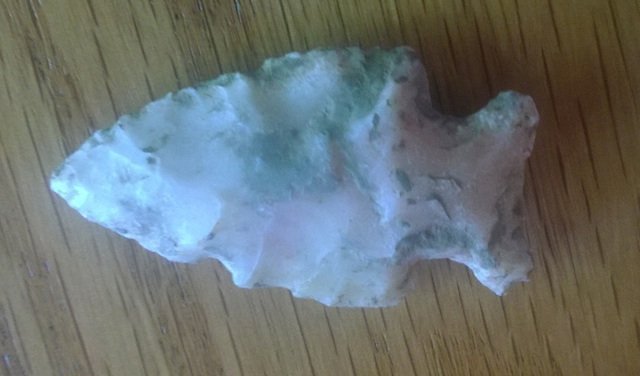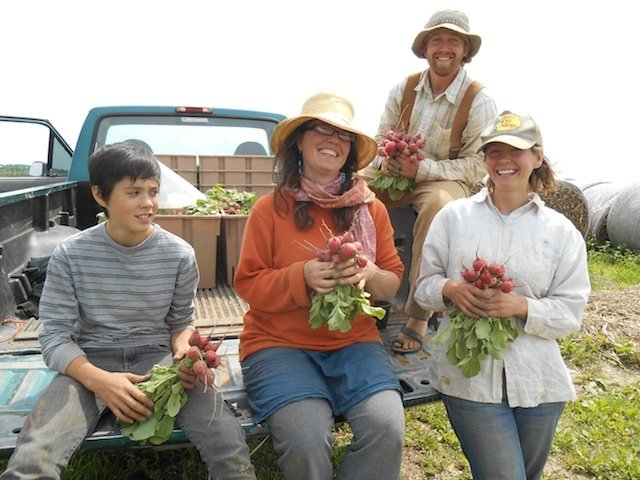
The behind the scenes of the farm would be fun for you to see. I sometimes wish we could get each of you to put on your old dirty work jeans, find an open day in your schedule and get down on the farm with us. We have a blast out here! We have a crew of 30 different Worker Shares and Sitter Shares who come out to the farm each week to work their designated 3 and a half hour shift and earn their family a CSA share. We also have three Full Time employees, Joe, Todd and Adrianne. We have something of a Small Family Farm out here. The Arrowhead we found in our field!
The Arrowhead we found in our field!
Within this Small Family, or community of helpers, we have a very diverse group of folks that range from their early teenage years to their mid seventies. Some of them are homeschoolers, some are professors, veterinarians, a handful of teachers, sociologists, mothers, fathers, builders and archaeologists to name just a few. It’s really fun to roll the dice and get a handful of people together on a farm from totally different backgrounds and have them do physical labor together on an organic vegetable farm for a few hours amidst the elements. We get talking about everything and anything out here.
We were particularly thankful to have an archaeologist on the crew this summer, Heather Walder, as we found an arrowhead in the field a couple weeks ago. Our archaeologist friend says that this arrowhead is from the Late Woodland People, a period in time approximately 1,200-1,700 years ago. Heather says that this style of point, called a “Honey Creek Corner-Notched”, would have been used on some of the first arrows shot with bows in this region, but earlier Native peoples made similar points for the tips of their hand-thrown spears. Heather says that it is made from a particular kind of stone called Chert that can be quarried near Prairie do Chien, Wisconsin.
So what we found on this farm was a small piece of stone that was handled by people who lived over 1200 years ago. It’s hard to fathom that amount of time. None of the trees or the plant life or the buildings of this farm would have looked then the way they do now. Just the bones of the farm would look the same. I try to imagine this farm stripped of it’s infrastructure, it’s electrical lines, it’s street signs, it’s everything. Just naked land. What animals would have roamed or lived here? What were the people hunting? It’s humbling to think about.
It got us thinking about what this farm would look like in another 1200 years. What remnants would be left of us? Maybe large pieces of steel from our equipment. Maybe some chunks of concrete. Who knows, maybe some heirloom fruit or vegetable seeds that keep re-seeding themselves over the years. We keep marching forward into the future. Every day of our lives we invest our energy into our work, our families, our community. I like to think that we’re working on nurturing a community of people. We’re building a lifestyle where the sustainable aspects will be gleaned from by future generations. Maybe we’ll leave re-mineralized, fertile soil for future generations. I like to think that we’ll walk gently here and that for the short period of time that we get to care for and steward this piece of land, we will love and nurture and hopefully leave it a better place than what we found it.
French Breakfast Radish- We still aren’t sure if the French really eat these for Breakfast? But we love their white tips and their red tops and their fun shape. Use these like you would the cherry bell radish. The greens are wonderful used for cooking, sauteeing or adding to your fritattas and egg bake dishes too!
Hakurai Salad Turnips- These have all the flavor of a Fall Turnip, but all the tenderness of a Spring radish. They’re in the same family as radishes. We recommend slicing them thin over salads. The turnip greens can also be used in cooking.  Everyone in motion busily harvesting french breakfast radishes.
Everyone in motion busily harvesting french breakfast radishes.
Strawberries– Another item that we do buy for you from a neighboring certified organic Amish farmer. We have a small strawberry patch on the farm, but it’s just not producing what we would need for all of our membership. Strawberries are highly perishable. They prefer 50 degree storage, so a referigerator is a little too cool and your countertop is a little too warm, so use them up quickly! But I’m guessing that won’t be a problem!
Tat Soi- This is an Asian Green in the brassica family, similar to the Pac Choi you received the last two weeks. Tat soi can be used a little more like spinach, but we’ve included a really fun recipe we think you’ll love!
Green Curly Kale (or Collards)- Culry Green Kale. Kale is probably my favorite green. I could eat it every day of my life! It is loaded with anti-oxidants and filled with minerals and chlorophyll that keeps my body feeling strong and healthy. Kale keeps best in a plastic bag in the fridge. Before you cook with it, strip the tough stems from the leaf and discard the stems. When we ran out of Curly Green Kale in the fields, we harvested Collard greens which can be used much like Kale in your cooking. Although some people are partial to cooking collards with bacon, and I think that sounds like a wonderful pair!
Red Oakleaf lettuce, Green Oakleaf Lettuce- Three heads per member this week! I love that in the spring time we can grow fun varieties of lettuce like these beautiful red and green oakleaf lettuces. You won’t find these tender heads at any supermarket. The best luck you’ll have is at a Farmer’s Market with vendors selling specialty produce. These are such a gem. From the heavy rains before Tuesday morning harvest, plenty of soil was splashed into the heads of the lettuce. We recommend cutting the butt of the end of your head of lettuce and giving each leave a good rinse and spin before eating in your salad. Keeps best in a plastic bag in your fridge. Salads for every meal!
Cilantro- A nice little giving of cilantro that conveniently compliments our Tat Soi recipe below! Cilantro will keep best in a plastic bag in the fridge as well.
Kohlrabi- These guys aren’t huge, but they’re so nice looking and tender. Kohlrabi is in the same family as kale, cabbage, broccoli, cauliflower and even Tat Soi-that humongus Brassica family of plants again. So you can use the leaves of your kohlrabi like you would kale in your cooking as well. Peel your kohlrabi with a pearing knife before slicing up the tender centers as a snack. Texture is similar to an apple.